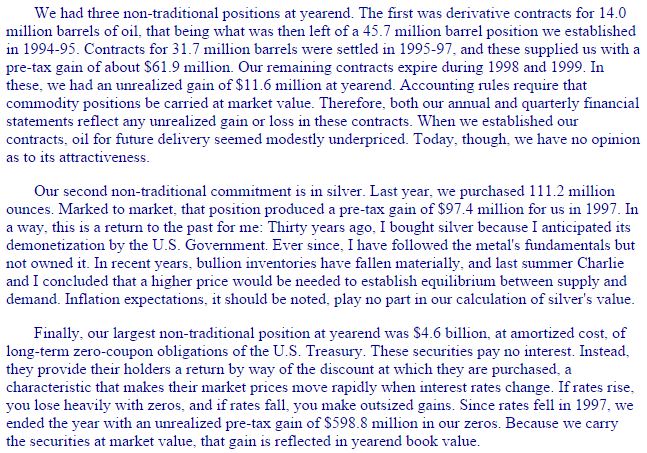I was glancing through the Berkshire letters from the late 1990’s because I recall Buffett briefly mentioning his large silver position he acquired and I was trying to see if Buffett referenced the specific cash cost of production. He didn’t in the letter—only mentioning that Berkshire acquired 111 million ounces. He has mentioned in other interviews that silver was in fact below the cost of production—a supply/demand imbalance that can persist for a while, but not forever.
Buffett felt comfortable loading up on silver (he took down roughly 25% of the world’s available inventory), and then just storing it in the vault until this supply/demand dynamic normalized. He didn’t have to wait long, as silver appreciated modestly back above the cost of production later that year, and Berkshire booked a nearly $100 million gain on Buffett’s unconventional investment.
Today, the cost of production of silver has fallen to around $8 per oz, and the price is around $14, so for anyone hoping that silver might be a bargain after a 3 year bear market, it is still nearly 100% above the relative level where it was when Buffett backed up the truck to load up… (note: this is the so-called “cash cost” of production, which excludes company overhead expenses, exploration costs, and capex–it’s just the actual cost to pull the metal out of the ground, which is the metric I believe Buffett used in his decision to buy it in the late 90’s).
Speaking of unconventional investments—these are ideas that I think Buffett really loves, although he talks far more in the recent letters about the great businesses (and for good reason, those are the businesses that provide the “sure” money).
Of course, in his partnership years, Buffett talks a lot about both “generals” (stocks that are purchased simply because they are undervalued) and “workouts” (stocks with some corporate catalyst or event that will help realize the valuation gap). The workouts tend to be more “unconventional”, but can provide profits that are often uncorrelated to what the general stock market is doing. In Buffett’s early days, this involved things like oil company mergers, cocoa bean arbitrage, closed end fund liquidations, special dividends, spinoffs, activist positions, and many others. These situations provided significant profits to Buffett personally in the early years, and then later for his partners.
Buffett even bought silver in the late 1960’s—although he wasn’t a gold (silver) bug, like so many today.
Anyhow, here is Buffett in the 1997 letter discussing a few unconventional investments that Berkshire participated in. These are quite small relative to Berkshire’s equity, but it still describes his affinity for making profits out of unconventional special situations:
The other interesting takeaway from this clip is that Buffett said he followed the fundamentals of silver for 3 decades without investing in it. Reminds me of how he talked about reading Bank of America annual reports and IBM annual reports for 50 years before ever buying a single share.
Patience—all knowledge is cumulative…



